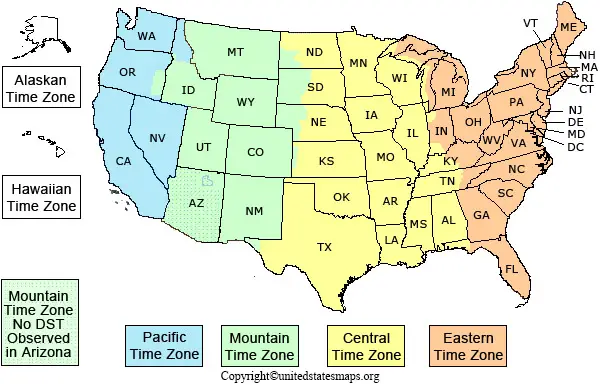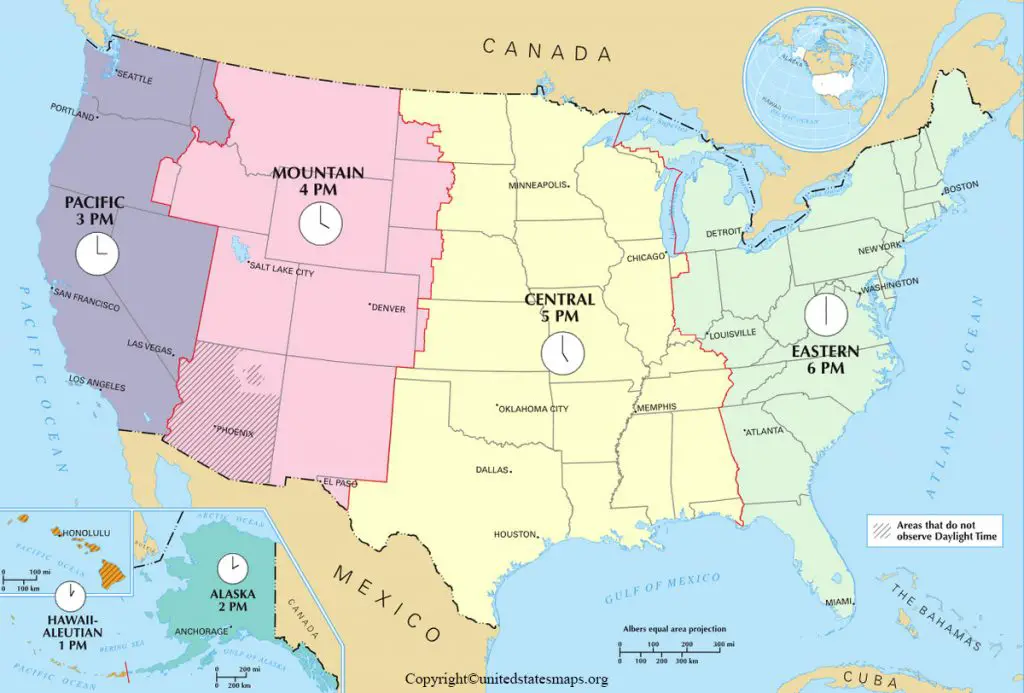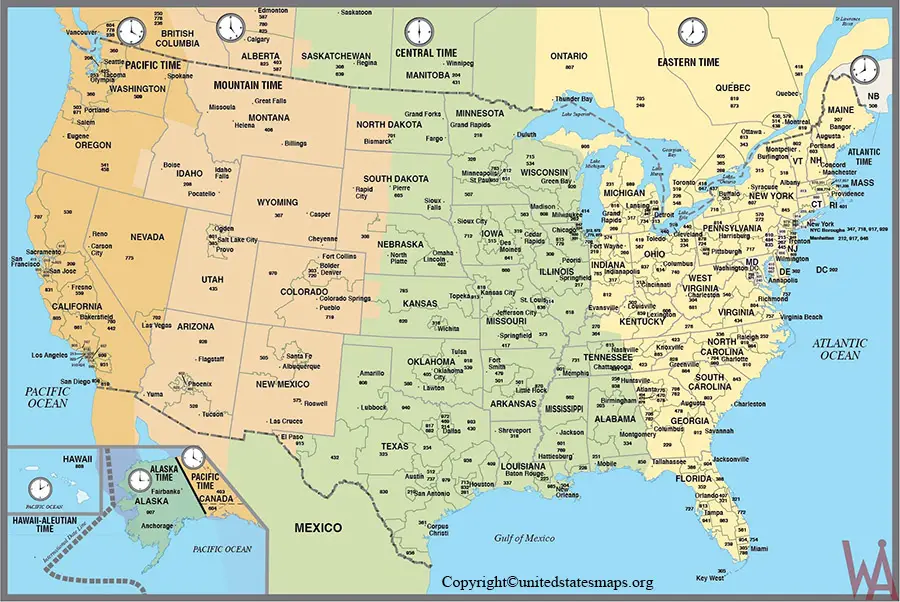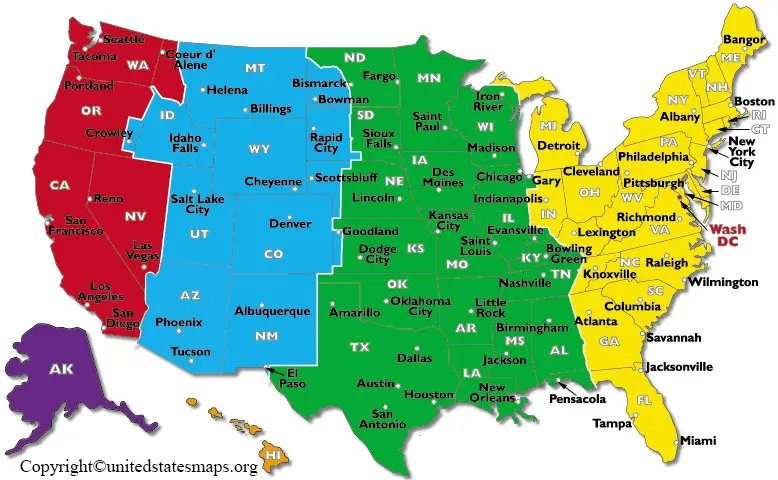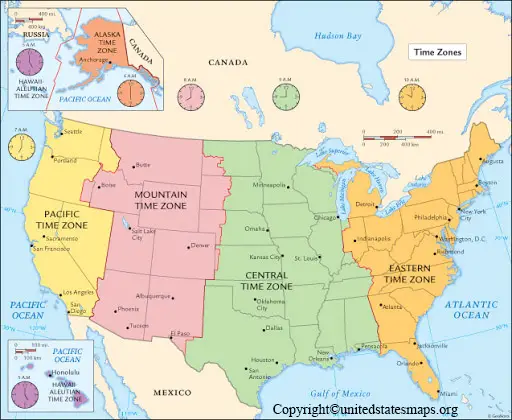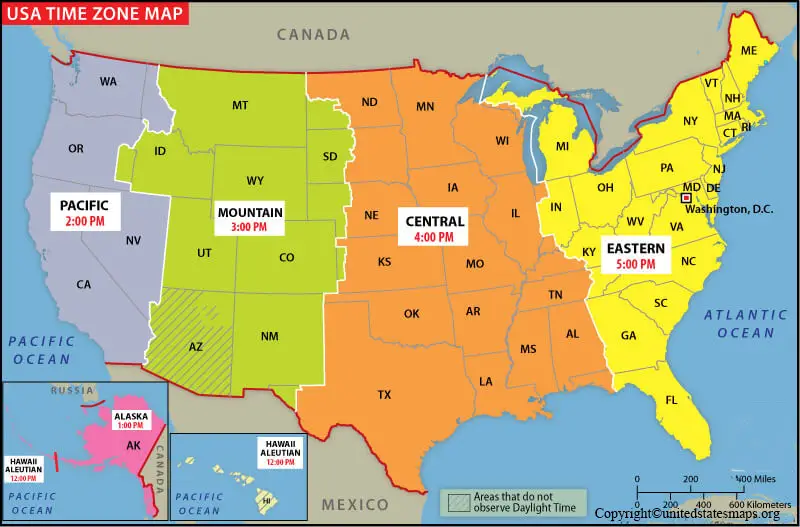US time zone map by law is divided into 9 time zones covering the states, territories, and other US possessions, with most of the united states observing daylight saving time. It is the combination of the US time zone and daylight saving rules and along with the timekeeping services, which determines the legal civil time for any U.S location at any moment.
- US Voting Map
- US Climate Map
- US Pipeline Map
- Coronavirus US Map
- US Senate Map
- US Map with Capitals
- Interactive US map
- Map of southeast US
- Road Map of US
- Geographical Map of USA
- US surface Weather Map
- America Time Zone Map
US Time Zone Map [Timezone Map of United States]
Before the adoption of four standard time zones for the continental United States, many towns and cities set their clock to noon when the sun passed their local meridian, pre corrected for the equation of time on the date of observation, to form local mean solar time. Noon occurred at different times but the time differences between distant locations were barely noticeable prior to the 19th century because of long travel times and the lack of long-distance instant communication prior to the development of the telegraph.
Printable Map of US Time Zones
A time zone is one of 24 spherical lunes with equal width-each assigned with one of the 24 hours. Each section observes a uniform standard time to keep track of the day and night cycle and also for legal, social and commercial purposes. In each geographic region within a time zone, people use the same time. All these zones are defined by an offset from the coordinated universal time by a number of hours centered on the prime meridian. You can see the all-time zones in this printable timezone map of USA.
WHY TIME ZONES WERE INTRODUCED?
- Time zones are crucial for standardizing time across countries and regions.
- The offset from the world’s standard time expressed as UTC- /UTC+ defines the local time within a time zone.
WHAT ARE THE DIFFERENT TIME ZONES IN THE UNITED STATES?
The US TIME ZONE MAP is divided into 9 categories:
From east to west they are —
- ATLANTIC STANDARD TIME (AST)
- EASTERN STANDARD TIME (EST)
- CENTRAL STANDARD TIME(CST)
- MOUNTAIN STANDARD TIME(MST)
- PACIFIC STANDARD TIME(PST)
- ALASKAN STANDARD TIME (AKST)
- HAWAII ALEUTIAN STANDARD TIME(HST)
- SAMOA STANDARD TIME (UTC-11)
- CHAMORRO STANDARD TIME (UTC+10)
US Time Zone Map with Cities
Standard time zones in the united states and other regions are currently defined at the federal level by law 15 USC 260.
| TIME ZONE | DST | STANDARD |
| ATLANTIC | Not observed | UTC- 04:00 |
| EASTERN | UTC-04:00 | UTC-05:00 |
| CENTRAL | UTC-05:00 | UTC-06:00 |
| MOUNTAIN | UTC-06:00 | UTC-07:00 |
| PACIFIC | UTC-07:00 | UTC-08:00 |
| ALASKA | UTC-08:00 | UTC-09:00 |
| HAWAI-ALEUTIAN | UTC-09:00 | UTC-10:00 |
| AMERICAN SAMOA | Not observed | UTC-11:00 |
| CHAMORRO | Not observed | UTC+10:00 |
US Time Zone Map with States (America)
From west to east:
HAWAII ALEUTIAN TIME(HAT)
- Hawaii – Aleutian standard time (HAST) (UTC-10)
- Hawaii Aleutian daylight time (HADT)(UTC-9)
ALASKA TIME (AST)
- Alaska standard time (AKST)(UTC-9)
- Alaska daylight time (AKDT)(UTC-8)
PACIFIC TIME (PT)
- Pacific standard time (PST)(UTC-8)
- Pacific daylight time (PDT)(UTC-7)
MOUNTAIN TIME (MT)
- Mountain standard time (MST)(UTC-7)
- Mountain daylight time(MDT)(UTC-6)
CENTRAL TIME (CT)
- Central standard time (CST)(UTC-6)
- Central daylight time (CDT) (UTC-5)
Time Zone Map of US (US Map and Time Zones)
US Day Light Saving Time: Daylight saving time is in use from Sunday 11 march 2018 (1 hr forward) until Sunday 4 November 2018 (1 hour backward). On the first Sunday in November areas on daylight saving time return to standard time at 2 am. Eastern standard time (EST)becomes eastern daylight time (EDT) and so forth.
US Map with Time Zone
Daylight saving time extended: On august 8,2005 president bush signed into law a broad energy bill (Energy policy act of 2005) that extended daylight saving time by four weeks beginning in 2007. The provisions of the bill called for daylight saving time to start on the first Sunday in April and ended on the last Sunday in October. The provision took effect on March 11, 2007.
The polls indicated most people were in favor of extending daylight saving time, and there were opponents who fought against the extension. According to the airline industry, it would cost millions of dollars to change schedules and some school systems had concerns that students would be waiting for the bus in darkness in the mornings.
EXTENDING DAYLIGHT-SAVING TIME PROPONENTS ARGUED:
- Energy savings- will possibly save around 1 lac barrels of oil daily. People will turn interior and exterior lights on later in the day which will save electricity.
- Recreations-people will have more time to enjoy outdoor activities such as golf, tennis, and theme parks.
- Farming- many farmers work part-time and will have an extra hour to work after they arrive home. Full-time farmers may not benefit.
EXTENDING DAYLIGHT-SAVING TIME OPPONENTS ARGUED:
- In the business-in airline industry, it costs millions to change schedules.
- Computers, clocks, and gadgets- many gadgets adjust automatically for daylight saving time.
USA clocks are now on:
- Daylight saving time began: on March 14, 2021, at 02:00 local time. The clock went forward one hour.
- Daylight saving time End: November 7, 2021, at 02:00 local time. The clock goes back one hour
